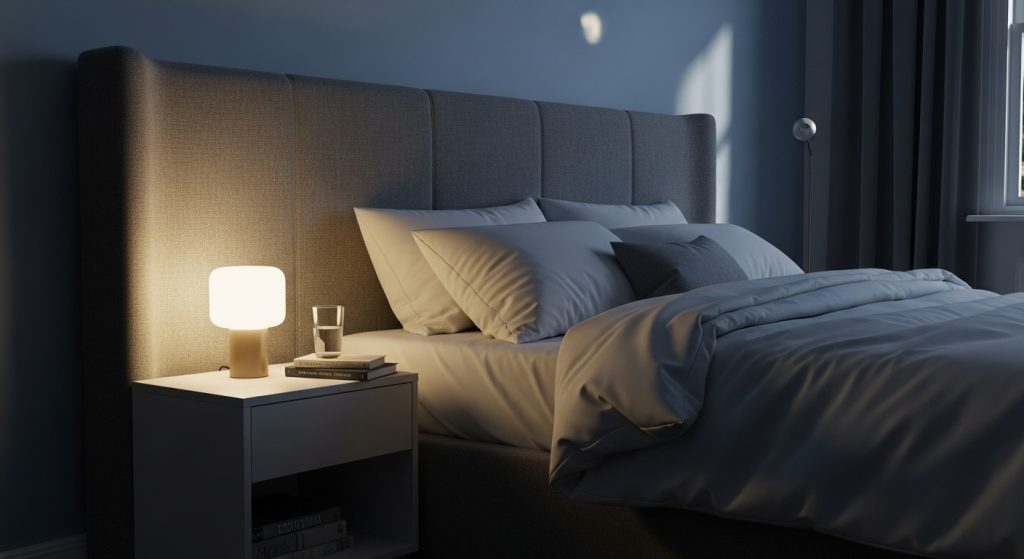Determining how tall should a nightstand be compared to your bed is a fundamental question in bedroom design that impacts both function and aesthetics. The nightstand is a crucial piece of furniture, serving as a convenient bedside companion. Choosing one at the correct height ensures comfortable use and creates a visually harmonious relationship between the bed and its adjacent furniture.

This definitive guide provides an expert, in-depth explanation of the principles behind ideal nightstand height. It covers measurement techniques, explores variations for different bed types, and offers professional tips for achieving a perfectly balanced and functional bedside setup.
What is the “Golden Rule” for Nightstand Height?
The “golden rule” for nightstand height is that the top surface of the nightstand should be roughly level with, or slightly higher than, the top surface of your mattress. This ergonomic guideline ensures that items placed on the nightstand are easily reachable from a reclined or seated position in bed. It provides the most comfortable and practical relationship between the bed and its companion table.
This rule serves as the foundational principle for selecting the right piece. While slight variations are acceptable, a nightstand that adheres closely to this guideline will almost always feel more comfortable and look more balanced than one that deviates significantly. It is the starting point for creating a functional and aesthetically pleasing bedside environment, a key aspect of our comprehensive nightstand guide.
Why is the Correct Nightstand Height So Important?
The correct nightstand height is important because it profoundly affects both the practicality of using the nightstand and the overall visual harmony of the bedroom. A nightstand at the wrong height can be inconvenient, uncomfortable, and visually jarring. Getting the scale right is crucial for creating a space that feels both functional and intentionally designed.
What Are the Functional Benefits of the Right Height?
The functional benefits are primarily ergonomic.
- Easy Reach: A nightstand level with the mattress allows you to easily reach items like a glass of water, your phone, or an alarm clock without excessive stretching or awkward movements, especially when lying down.
- Comfortable Lamp Use: It positions a bedside lamp at an appropriate height for reading in bed, minimizing glare and providing focused illumination.
- Reduced Accidents: It minimizes the risk of knocking items off the nightstand when reaching for them in the dark or upon waking. These practical advantages contribute significantly to nighttime comfort and convenience. Ergonomic design principles consistently emphasize the importance of reachability for frequently used items.
How Does Correct Height Create Aesthetic Balance?
Correct height creates aesthetic balance by establishing a pleasing visual connection between the bed and the nightstand. When the nightstand is level with the mattress, it creates a smooth, horizontal line that feels calm and cohesive. This visual continuity makes the bed area feel grounded and well-proportioned. It avoids the awkward visual disconnect that occurs when a nightstand is significantly too tall or too short. Achieving this balance is a key goal in professional bedroom design.
What Problems Arise from a Nightstand Being Too Low?
A nightstand that is too low presents several problems.
- Difficult Reach: Reaching down for items can be awkward and uncomfortable, especially from a lying position.
- Visual Disconnect: It can look visually “weak” or disconnected from the taller mass of the bed.
- Lamp Height Issues: A table lamp placed on a low nightstand may not provide adequate light for reading in bed, as the shade might be below shoulder level.
- Potential for Clutter: Items may be more easily knocked off the surface.
What Problems Arise from a Nightstand Being Too High?
A nightstand that is significantly too high also creates issues.
- Awkward Reach: Reaching up and over for items can be just as inconvenient as reaching down.
- Visual Imbalance: It can visually “crowd” the bed, making the space feel less open and restful. It can create a disjointed, top-heavy look.
- Obstructed View: A very tall nightstand might obstruct the view from the bed or feel like a barrier.
- Potential Hazard: Items placed near the edge are more likely to be knocked off onto the bed or the sleeper. Avoiding these issues is a common theme in lists detailing common nightstand buying mistakes to avoid.
How Do You Measure Your Bed Height Correctly?
Measuring your bed height correctly is the most critical step in determining your ideal nightstand height. This measurement must reflect the actual height where you sleep, including all bedding components. A precise measurement is the foundation for making an informed purchase decision.
Step 1: What Do You Need to Measure?
You need to measure the vertical distance from the floor to the very top surface of your mattress when the bed is fully made. This is crucial because factors like mattress toppers, thick duvets, or even the compression of the mattress over time can affect the final height. Do not simply measure the height of the mattress itself off the bed frame.
Step 2: How to Take the Measurement Accurately?
Use a reliable tape measure.
- Ensure your bed is placed where it normally sits in the room, on its final flooring (carpet, rug, hardwood).
- Make the bed as you normally would, including any mattress toppers, fitted sheets, and top bedding (like a duvet or comforter).
- Place a long, rigid, flat object (like a hardcover book or a level) horizontally across the top center of the made mattress, extending slightly over the side where the nightstand will go.
- Measure the vertical distance from the floor up to the underside of this flat object. This is your true mattress top height.
- Take the measurement a couple of times to ensure accuracy.
Why is Measuring with Bedding So Important?
Measuring with bedding is important because thicker bedding, especially plush mattress toppers or lofty duvets, can add several inches to the effective height of the mattress surface. Measuring only the bare mattress height can lead you to choose a nightstand that ends up being too short once the bed is fully dressed. This level of detail ensures the final relationship between mattress and nightstand is ergonomically correct.
What is the Ideal Height Range Relative to the Mattress?
While the “golden rule” suggests being level with the mattress, a slight range offers more flexibility and often better results. The ideal height range for a nightstand is generally considered to be from 1 inch below the mattress top to about 2-4 inches above the mattress top. Staying within this range ensures both functional comfort and visual harmony.
Most designers agree that it is generally better for a nightstand to be slightly taller than slightly shorter. A slightly taller nightstand still allows for easy reach. It also creates a subtle visual hierarchy that can feel more grounded. A nightstand that is noticeably shorter than the mattress often looks awkward and disconnected. Therefore, aiming for level with the mattress or up to 4 inches taller is the professional recommendation.
How Do Different Bed Styles Affect Nightstand Height Choices?
Different bed styles have vastly different mattress heights, which directly impacts the ideal nightstand height. Modern platform beds sit much lower than traditional beds with box springs. This variation must be accounted for when selecting appropriately scaled nightstands.
What Are the Considerations for Low Platform Beds?
Low platform beds, often associated with modern and minimalist design, require correspondingly low nightstands. A standard-height nightstand will tower awkwardly over a low platform bed, disrupting the clean, horizontal lines of the style. Look for nightstands specifically designed with a lower profile, often under 20 inches tall. Wall-mounted floating nightstands are also an excellent solution for very low beds. They can be installed at the perfect height, regardless of the bed’s minimal elevation.
How to Choose for Traditional Beds with Box Springs?
Traditional beds, often featuring both a mattress and a box spring, sit much higher off the ground. These taller beds require taller nightstands to maintain the correct ergonomic relationship. Nightstands in the 28-30 inch height range are common for these setups. Using a standard-height (e.g., 24-inch) nightstand next to a tall traditional bed will make it look underscaled and feel inconveniently low.
What About Adjustable Beds?
Adjustable beds present a unique challenge, as the mattress height can change when the head or foot is elevated. In this case, the measurement should be taken when the bed is in its flat, neutral position. Choose a nightstand height based on this flat measurement. While the relationship will change when the bed is adjusted, this provides the best compromise for overall usability and visual balance when the bed is not in motion.
How Does Mattress Thickness Play a Role?
Modern mattresses come in a huge range of thicknesses, from slim 8-inch models to luxurious 16-inch pillow-tops. This thickness variation is a major factor in the final mattress height. Always base your nightstand choice on the height of your specific mattress on your specific bed frame, not on standard assumptions. Two beds with the same frame can have vastly different mattress heights due to the mattress choice alone.
What If You Cannot Find a Nightstand of the Perfect Height?
Finding a nightstand that perfectly matches your measured mattress height can sometimes be challenging. If you fall in love with a piece that is slightly off, there are several strategies and compromises to consider. The key is to prioritize function while still aiming for a visually pleasing result.
Should You Prioritize Function or Aesthetics?
In most cases, function should be prioritized. A nightstand that looks beautiful but is uncomfortable to use daily will ultimately be a source of frustration. If forced to choose between a nightstand that is slightly too tall versus slightly too short, opt for the slightly taller one. As mentioned, this generally feels more comfortable ergonomically and looks better visually than one that is too low.
Can Bed Risers Be a Solution?
If your bed frame allows for it, simple bed risers placed under the legs can slightly elevate the entire bed. This can be a solution if your preferred nightstands are slightly taller than your current mattress height. However, this will also affect the overall look of your bed and may not be aesthetically desirable.
Is a Slightly Taller Nightstand Acceptable?
Yes, a nightstand that is slightly taller (within the 2-4 inch range above the mattress) is perfectly acceptable and often preferred. This height still allows for comfortable reach and looks visually balanced. Problems generally arise only when the nightstand is dramatically taller (e.g., 6+ inches above the mattress).
When Are Wall-Mounted Options the Best Compromise?
Wall-mounted floating nightstands or simple shelves offer the ultimate flexibility in height. They can be installed at the exact perfect height relative to your mattress, regardless of any unusual bed dimensions. This makes them an excellent solution for very low platform beds, very high antique beds, or situations where standard-sized nightstands simply do not work. They also offer a clean, minimalist aesthetic.
How Does Nightstand Height Impact Your Choice of Lamp?
The height of your nightstand directly impacts the ideal height for your bedside lamp. The goal is to position the bottom of the lampshade roughly level with your chin when you are sitting up in bed reading. This ensures the light falls correctly on your book and the bulb is not shining directly in your eyes.
A taller nightstand requires a shorter lamp. A shorter nightstand requires a taller lamp. The key measurement is the combined height of the nightstand surface plus the lamp base and shade. This combined height should bring the bottom of the shade to that optimal chin level. Consider this relationship when selecting both your nightstand and your lamp to ensure a comfortable and functional reading setup.
Should Both Nightstands Flanking the Bed Be the Same Height?
Ideally, yes, both nightstands flanking a bed should be the same height for visual symmetry and balance. This creates a cohesive and intentional look. Even if the nightstands themselves are intentionally mismatched in style, maintaining the same height provides a crucial element of consistency.
However, there can be exceptions. If two partners have significantly different mattress height preferences (e.g., due to different mattress toppers or adjustable bed settings), using nightstands of slightly different heights might be a necessary functional compromise. In this case, try to keep the difference minimal. Use lamps of different heights to bring the overall height of the vignettes (table + lamp) into closer visual balance.
Conclusion
The answer to how tall should a nightstand be compared to your bed is rooted in a simple principle: aim for level with the top of your mattress, or slightly higher (up to 4 inches). This guideline ensures ergonomic comfort and creates a visually harmonious balance. The most critical step is to accurately measure your actual bed height, including all bedding. By prioritizing function, understanding scale, and considering your specific bed style, you can confidently choose nightstands that are not just beautiful accessories but perfectly tailored partners for your most personal space. This thoughtful approach is the key to creating a bedroom sanctuary that is both stylish and supremely comfortable.











